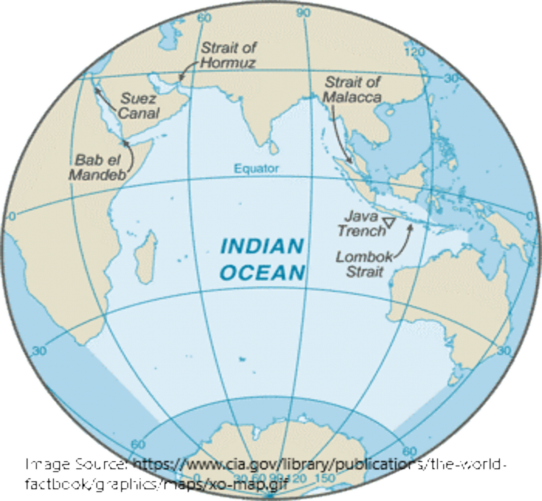Map7.1-The Indian Ocean

1.1. The Indian Ocean
♤ Indian Ocean, covers approximately one-fifth of the total ocean area of the world.
♤ It is the smallest, geologically youngest, and physically most complex of the world’s three
major oceans.
♤ It stretches for more than 6,200 miles (10,000 km) between the southern tips of Africa and Australia and, without its marginal seas, has an area of about 28,360,000 square miles (73,440,000 square km).
♤ The decision by the International Hydrographic Organization in 2000 to delimit a fifth ocean, the Southern Ocean, removed the portion of the Indian Ocean south of 60 degrees south latitude.
♤ The Indian Ocean’s average depth is 12,990 feet (3,960 metres), and its deepest point, in the Sunda Deep of the Java Trench off the southern coast of the island of Java (Indonesia), is 24,442 feet (7,450 metres).
1.1.1. Significance of the Indian Ocean
♤ Four critically important access waterways are the Suez Canal (Egypt), Bab el Mandeb (Djibouti-Yemen), Strait of Hormuz (Iran-Oman), and Strait of Malacca (Indonesia- Malaysia).
♤ The Indian Ocean provides major sea routes connecting the Middle East, Africa, and East Asia with Europe and the Americas. It carries a particularly heavy traffic of petroleum and petroleum products from the oilfields of the Persian Gulf and Indonesia.
♤ It has significant fisheries resources to the bordering countries for domestic consumption and export. Fishing fleets from Russia, Japan, South Korea, and Taiwan also exploit the Indian Ocean, mainly for shrimp and tuna.
♤ Large reserves of hydrocarbons are being tapped in the offshore areas of Saudi Arabia, Iran, India, and western Australia. An estimated 40% of the world's offshore oil production comes from the Indian Ocean.
♤ Beach sands rich in heavy minerals and offshore placer deposits are actively exploited by bordering countries, particularly India, South Africa, Indonesia, Sri Lanka, and Thailand.

♤ Major Seaports: Chennai (India); Colombo (Sri Lanka); Durban (South Africa); Jakarta (Indonesia); Kolkata (India); Melbourne (Australia); Mumbai (India); Richards Bay (South Africa)
♤ International Trade: Indian Ocean and its various channels are responsible for two-thirds of world’s oil shipment, one third of world’s cargo movement and nearly half of its container traffic movement.
